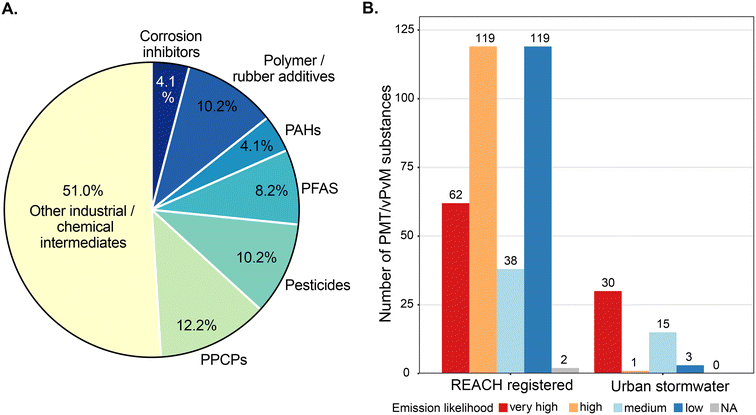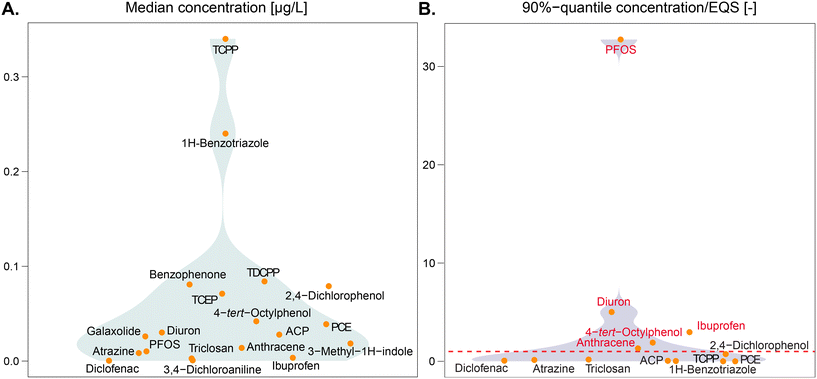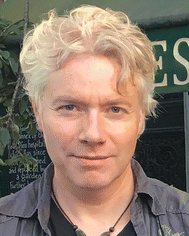 Open Access Article
Open Access ArticleCreative Commons Attribution 3.0 Unported Licence
Urban stormwater capture for water supply: look out for persistent, mobile and toxic substances
Lena
Mutzner
 *a,
Kefeng
Zhang
*a,
Kefeng
Zhang
 b,
Richard G.
Luthy
b,
Richard G.
Luthy
 c,
Hans Peter H.
Arp
c,
Hans Peter H.
Arp
 de and
Stephanie
Spahr
de and
Stephanie
Spahr
 *f
*f
aEawag, Swiss Federal Institute of Aquatic Science and Technology, 8600 Dübendorf, Switzerland. E-mail: lena.mutzner@eawag.ch
bWater Research Centre, School of Civil and Environmental Engineering, UNSW Sydney, High St, Kensington, NSW 2052, Australia
cDepartment of Civil and Environmental Engineering, Stanford University, Stanford 94305, California, USA
dNorwegian Geotechnical Institute (NGI), NO-0806 Oslo, Norway
eDepartment of Chemistry, Norwegian University of Science and Technology (NTNU), NO-7491 Trondheim, Norway
fDepartment of Ecohydrology and Biogeochemistry, Leibniz Institute of Freshwater Ecology and Inland Fisheries, Müggelseedamm 301, 12587 Berlin, Germany. E-mail: stephanie.spahr@igb-berlin.de
First published on 19th July 2023
Abstract
Urban stormwater was traditionally managed for flood control and property protection. But this view is changing as urban stormwater is increasingly recognized as an underused water resource. As cities implement stormwater capture, treatment, and use practices, there is a growing need to address water quality criteria beyond traditional pollutants such as nutrients, total suspended solids, pathogens, and metals. Current use practice and regulations are lacking on the occurrence of persistent, mobile and toxic (PMT) and very persistent, very mobile (vPvM) organic substances. These substances are poorly removed in conventional stormwater treatment systems, e.g., urban blue-green infrastructure, and, thus, may pose a risk when urban runoff is used to augment drinking water sources or discharged to surface waters. We reviewed 97 stormwater monitoring studies and identified 49 PMT/vPvM substances detected in urban stormwater. Although detection does not equate with risk, this highlights the potential importance of urban stormwater as a source of PMT/vPvM substances released to water resources. There is a lack of surveillance data on PMT/vPvM substances in urban stormwater and their fate in stormwater control measures, which hinders reliable risk assessments of stormwater capture. Unified guidelines are needed to (i) monitor PMT/vPvM substances in urban stormwater runoff, (ii) assess the human and environmental risks PMT/vPvM substances may pose for urban stormwater capture and use, and (iii) establish improved stormwater management and use criteria to ensure safe stormwater capture for water supply.
Water impactPersistent, mobile and toxic (PMT) substances pose a threat to water supplies and aquatic ecosystems. However, their occurrence in urban stormwater is largely unknown, which hinders reliable risk assessment of stormwater capture and use. This review presents our current knowledge on PMT substances in urban stormwater and identifies future research needs for improved stormwater monitoring and management. |
1 Urban stormwater risk to water resources and water supply
Urbanization, climate change, and water scarcity are leading to new perspectives on urban stormwater in terms of both runoff quantity and quality. Impervious surfaces result in increased stormwater runoff, which can lead to flooding in urban areas and decreased water quality. Urban stormwater runoff from roads, parking lots, building façades, roofs, or green spaces can contain a variety of contaminants including nutrients, metals, total suspended solids, pathogens, microplastics, and trace organic contaminants.1–7 Trace organic contaminants in runoff include pesticides, vehicle-related compounds, polycyclic aromatic hydrocarbons (PAHs), pharmaceuticals and personal care products (PPCPs), and many other compounds such as organophosphate flame retardants and per- and polyfluoroalkyl substances (PFAS).1,2,7,8 Urban stormwater can be a risk to freshwater resources, i.e., rivers, lakes, and groundwater.7,9–12 For instance, biocides used on flat roofs were detected in groundwater due to infiltration of urban stormwater,13 and acute mortality of coho salmon was related to a tire rubber-derived chemical in urban stormwater.14 Lack of guidance on trace constituents in urban stormwater can be a barrier for stormwater harvesting to augment water supplies.15Amongst the various trace organic contaminants in urban stormwater, those that are persistent, mobile, and toxic (PMT) or very persistent and very mobile (vPvM), collectively referred to as PMT/vPvM substances are of particular concern. Due to their persistence in the environment and mobility in soils, groundwater, and artificial barriers, PMT/vPvM substances may pose a risk to groundwater and surface waters when emitted.16–20
In response to the concern of these substances, Europe has recently adopted and defined PMT/vPvM hazard classes for organic substances as part of the revision to the regulation on classification, labelling, and packaging of chemicals (CLP), Regulation EC 1272/2008.21 For a substance to obtain the PMT/vPvM hazard classification in the CLP regulation, it would meet the following conditions. First, the substance must be either persistent (P) or very persistent (vP), referring to a simulated half-life in freshwater >40 or >60 days, respectively, or a simulated half-life in soils/freshwater sediments >120 or >180 days, respectively. Second, the substance must be mobile (M) or very mobile (vM) based on its lowest log soil organic carbon-water partition coefficient, log![[thin space (1/6-em)]](https://www.rsc.org/images/entities/char_2009.gif) KOC, between a pH of 4–9. Substances with a lowest log
KOC, between a pH of 4–9. Substances with a lowest log![[thin space (1/6-em)]](https://www.rsc.org/images/entities/char_2009.gif) KOC < 3 are considered mobile (M) and <2 very mobile (vM). Substances that meet the P and M criteria, and are additionally considered toxic, are considered PMT substances. Substances that meet the vP and vM criteria are considered vPvM, and may additionally be considered PMT if also toxic.
KOC < 3 are considered mobile (M) and <2 very mobile (vM). Substances that meet the P and M criteria, and are additionally considered toxic, are considered PMT substances. Substances that meet the vP and vM criteria are considered vPvM, and may additionally be considered PMT if also toxic.
To date, data on the occurrence and toxicity of PMT/vPvM substances in water resources is spotty, and reliable hazard assessment only exists for a small set of compounds. This situation is further confounded by data gaps owing to few commercial laboratories having the capacity to measure unregulated highly mobile, polar organic substances.16,20 A recent list includes 340 PMT/vPvM substances that are registered under the European Union's REACH regulation (Registration, Evaluation, Authorisation and Restriction of Chemicals, Reg. (EC) 1907/2006) along with their relative emission likelihood.22 These PMT/vPvM substances are identified based on guidance for assessing the persistency, mobility, and toxicity criteria, as detailed in Arp and Hale.19,23
Most conventional stormwater treatment systems are designed to remove suspended solids and regulated pollutants, and highly soluble PMT/vPvM substances are expected to be poorly removed in these treatment systems.2,24–26 Water quality and health risks must be carefully evaluated before augmenting water supplies with urban stormwater on a widespread basis. However, there is a lack of data on the occurrence and levels of problematic PMT/vPvM substances in urban stormwater, leading to unknown risks for freshwater resources, urban stormwater recharge of aquifers, and augmentation of water supplies. The goal of this review is to explore current knowledge on PMT/vPvM substances in urban stormwater by addressing the following questions: 1. Which PMT/vPvM substances have been found in urban stormwater thus far? 2. What is the status of knowledge on their risks for freshwater resources and stormwater harvesting? 3. What are the challenges related to PMT/vPvM substances and future needs to increase innovation in urban stormwater capture? This effort can help focus attention on the potential relevance and toxicity of PMT/vPvM substances in urban runoff for water resources.
2 Special concern: persistent, mobile, and toxic substances in stormwater
Literature review for PMT/vPvM substances in urban stormwater
We collected and reviewed 97 studies on Scopus reporting all types of dissolved and particle-associated trace organic contaminants (including e.g., pesticides, PAHs, and PFAS but excluding metals) in urban stormwater from the 1990s to 2022 (list of studies shared in the following repository: https://doi.org/10.5281/zenodo.7973643). No study specifically focused on the occurrence and concentration of persistent and mobile organic substances in urban stormwater. A metadata analysis revealed a total of 542 trace organic contaminants found in urban stormwater around the globe in concentrations above the respective limit of quantification. All studies were included in the metadata analysis independent of the chosen sampling strategy (grab sampling, composite sampling). We selected only studies that measured stormwater from urban areas, not agricultural land, however, the wide variety of urban land use categories does not allow a clear classification of the monitoring sites. The identification of PMT/vPvM substances in urban stormwater was done by comparing the chemical identifier InChIKey with a recent list of 340 REACH-registered PMT/vPvM substances following the proposed criteria by the German Environment Agency.22 In our search for stormwater quality data, we focused on studies measuring a range of contaminants in runoff from urban catchments. Moreover, we searched Scopus for PMT/vPvM substances with a very high emission likelihood22 to ensure that we have not missed any relevant study. The list of PMT/vPvM substances detected in monitoring studies of urban stormwater is shared in the following repository https://doi.org/10.5281/zenodo.7973643. For selected substances, reliable data from composite water sampling was available, and thus summary concentration statistics (i.e., calculation of median and quantiles) were performed on previously collected monitoring data.8 For substances that were measured both as filtered (dissolved) and non-filtered (total), the total concentration was used for further calculations. For substances that were only measured in dissolved form, the dissolved concentration was taken.Occurrence of PMT/vPvM substances in urban stormwater
Of the REACH-registered 340 PMT/vPvM substances, 14.4% (49 in total; 32 PMT/vPvM, 9 PMT, 8 vPvM) were detected at least in one study in stormwater above the limit of quantification, underscoring that stormwater can be an overlooked pathway of PMT/vPvM substances (Fig. 1). PMT/vPvM substances in urban stormwater can originate from a wide range of sources and often a clear allocation to one urban source is not possible. We classified the main urban use of the 49 PMT/vPvM substances found in urban stormwater based on their reported usages (Fig. 1A). We differentiated the PMT/vPvM substance uses into i) 4.1% corrosion inhibitors such as 1H-benzotriazole, ii) 10.2% polymer or rubber additives, plasticizers, flame retardants (polymer/rubber additives) such as tris(2-chloroethyl) phosphate or 1,3-diphenyl guanidine, iii) 4.1% PAHs such as anthracene, iv) 8.2% PFAS such as perfluorooctanesulfonic acid (PFOS), v) 10.2% pesticides including herbicides and biocides such as diuron, vi) 12.2% pharmaceuticals and personal care products (PPCPs) such as diclofenac; and vii) 51.0% other industrial substances and chemical intermediates registered under REACH including solvents, degreasers, and paint removers. With 51.0% of all PMTs/vPvMs found in urban stormwater, other industrial substances comprise the biggest group representing the most diverse uses. An obvious reason for this is that REACH-registered PMT/vPvM substances were used as the comparison to substances detected in urban stormwater. The REACH list was established for industrial substances, but not specifically pesticides or PPCPs unless they also have an additional industrial use. | ||
| Fig. 1 A. PMT/vPvM substances detected in urban stormwater (total 49) with the corresponding use class. B. Emission likelihood of the 49 PMT/vPvM substances found in urban stormwater compared to the list of 340 PMT/vPvM substances registered under REACH.22 | ||
Stormwater contains PMT/vPvM substances with a very high emission likelihood
The emission index for the REACH-registered PMT/vPvM substances has been estimated based on tonnage registered in REACH and the sum of scores of individual use characteristics19 in combination with monitoring data. A ‘very high’ emission likelihood relates to a high emission score in combination with detection in raw water, drinking water, or groundwater. REACH-registered PMT/vPvM substances with very high emission likelihood to water resources (red in Fig. 1B) have been detected in urban stormwater, with 30 of 62 PMT/vPvM substances with high emission likelihood (48.4%) found in urban stormwater. Among these 30 PMT/vPvM substances detected in urban stormwater are the corrosion inhibitor 1H-benzotriazole, the biocide diuron, the tire leachate chemical 1,3-diphenyl guanidine, and the PFAS perfluorohexanoic acid for example reported in ref. 3, 7, 13 and 27–31. Hence, urban stormwater can be a relevant pathway for PMT/vPvM substances found in water resources.3 The risk of PMT/vPvM substances in stormwater to water resources
Water scarcity in many urban environments has driven innovation toward the use of alternative water resources such as urban stormwater to augment water supplies.15,32 Stormwater can be captured and if required treated for non-potable uses such as toilet flushing, washing, irrigation, groundwater recharge, or potable use with prior treatment.15 However, for many PMT/vPvM substances, there is a lack of concentration data in urban stormwater to assess the risk for water resources and stormwater harvesting. Summary concentration statistics based on previously collected monitoring data8 were only possible for 19 of the 49 PMT/vPvM substances found in stormwater. Fig. 2A shows the measured median concentrations of these substances ranging from 0.0002 μg L−1 for diclofenac to 0.3 μg L−1 for tris(2-chloro-1-methylethyl) phosphate. A comparison of the 90%-quantile concentration shows that 10 out of 19 PMT/vPvM substances occur in concentrations higher than 0.1 μg L−1, used as precautionary threshold for pesticides in the EU Drinking Water Directive (EU Regulation 98/83/EC): diuron, benzophenone, anthracene, 2,4-dichlorophenol, tris(2-chloro-1-methylethyl) phosphate, tris(1,3-dichloro isopropyl) phosphate, 4-tert-octylphenol, 1H-benzotriazole, tris(2-chloroethyl) phosphate, and acenaphthene. It should be noted that some of these substances would not be considered PMT/vPvM substances using the more stringent criteria developed by the European Commission: anthracene, tris(2-chloro-1-methylethyl) phosphate, 4-tert-octylphenol, and acenapthene.22 For some substances, environmental quality standards (EQS) are available as threshold criteria for toxicity in the aquatic environment that would be relevant in the case of stormwater discharges to surface waters. We found chronic EQS values for 13 PMT/vPvM substances,8 with five compounds (diuron, anthracene, PFOS, ibuprofen, and 4-tert-ocytlphenol) having a 90%-quantile concentration higher than the EQS (Fig. 2B). Thus, there is a clear indication that urban stormwater contains PMT/vPvM substances at concentrations potentially relevant to the aquatic environment. Most importantly, our analysis demonstrates the lack of statistically sound concentration data for PMT/vPvM substances and the unknown risk to human health and the environment, particularly in the context of stormwater discharge or the potential widespread use of stormwater to augment urban water supplies. PMT/vPvM substances could, thus, be continuously recycled due to stormwater use, increasing the exposure to the urban population as emissions and recycling continue.20 | ||
| Fig. 2 Distributions of PMT/vPvM substances in urban stormwater as violin plot (geom_violin, ggplot, R 2022.07.1). Substances are shown with orange points (labeled) and scattered on the x-axis for better visibility (geom_scatter, ggplot, R 2022.07.1). Substance abbreviations: TCPP: tris(2-chloro-1-methylethyl) phosphate, TCEP: tris(2-chloroethyl) phosphate, TDCPP: tris[2-chloro-1-(chloromethyl)ethyl] phosphate, PCE: tetrachloroethylene, ACP: acenaphthene, PFOS: perfluorooctanesulfonic acid. Concentration data are based on Mutzner et al.8 A. Median concentration of 19 PMT/vPvM substances and B. Ratio of 90%-quantile concentrations to environmental quality standards (EQS) for 13 PMT/vPvM substances. The red dashed line shows a ratio of 1, substances with red font have a ratio bigger than 1. | ||
4 Many PMT/vPvM substances are not analyzed in urban stormwater
There are no known regular monitoring data for stormwater for many of the PMT/vPvM substances presented by Arp et al. (2023)22 that received a high or very high emission likelihood ranking. In the analyzed studies, 291 of the 340 PMT/vPvM substances were not reported within our urban stormwater literature search, indicating an (earlier) analytical gap as well as a monitoring gap. In total, there are 32 very high emission and 118 high emission PMT/vPvM substances (Fig. 1B) that have not been detected or monitored based on our comprehensive list of trace organic contaminants detected in stormwater. Further effort to expand the number of PMT/vPvM substances monitored in urban stormwater is therefore strongly needed.Stormwater monitoring campaigns should include PMT/vPvM substances, as several of these problematic substances could be present. One example of a vPvM substance that is likely to be present in urban stormwater but not yet screened for is the ultra-short-chain PFAS trifluoroacetate (TFA).33,34 TFA is most likely present in urban stormwater, as it has been reported to be ubiquitous in precipitation due to formation in the atmosphere from diverse PFAS precursors.35–38 Thus, urban stormwater is expected to be a relevant input pathway of TFA into the aquatic environment. Another example of a potentially relevant substance in urban stormwater is melamine. Melamine is a transformation product of hexamethoxymethylmelamine (HMMM, a tire rubber constituent) found frequently in urban stormwater.9,39,40
5 Future challenges and needs
Lack of knowledge on the occurrence of PMT/vPvM substances in urban stormwater
There is a lack of data on trace organic contaminants in stormwater, especially information on PMT/vPvM substances is very scarce. To date, 14.4% of PMT/vPvM substances registered under REACH were measured in urban stormwater, but many more are likely present. It is uncertain how many PMT/vPvM substances can occur and at which frequency and concentration levels due to monitoring and analytical gaps, as well as inconsistent data reporting.8,16,33 More data on precursors are needed, particularly in urban areas discharging or recycling stormwater. This will allow prioritization and ranking of PMT/vPvM substances to facilitate monitoring efforts.Risks related to PMT/vPvM substances in urban stormwater are largely unknown
Our analysis shows that PMT/vPvM substances in urban stormwater may pose a potential risk to human health and the environment. For 19 PMT/vPvM substances, concentrations were available; 10 of these compounds were found in stormwater at concentrations greater than 0.1 μg L−1. But detection does not equate with risk. For example, five PMT/vPvM occurred in concentrations above the respective threshold EQS values for aquatic organisms. Highly mobile substances have often been ignored in (eco)toxicological studies, as they tend to not be bioaccumulative, but may be present in water supplies over long periods.41 Therefore, toxicity studies considering long-term water exposure of non-bioaccumulative substances, such as short-chain PFAS, are only just emerging. Collectively, such studies suggest that risks are unknown or largely underestimated.42,43 The diversity of PMT/vPvM substances should also be addressed, as exposure to chemical mixtures is potentially more harmful than single PMT/vPvM substances.44–46Other PMT/vPvM substances and transformation products
This study considered a list of PMT/vPvM substances registered for industrial uses under REACH;22 however, this is only a partial list of PMT/vPvM substances on the global market, as non-industrial substances can also be PMT/vPvM substances, including pharmaceuticals,47 biocides, and pesticides.23 Another important source is transformation products. Though transformation products of substances are not necessarily more persistent than their precursors, they tend to be more mobile.48 Substances that contain a persistent moiety can form PMT/vPvM substances in the environment, such as the above example with hexamethoxymethylmelamine, as well as substances with short, perfluoroalkyl side chains that form short-chain PFAS including trifluoroacetic acid.33 However, research on the emergence of PMT/vPvM transformation products is only in its infancy.Inorganic persistent and mobile substances
Although the PMT/vPvM criteria mainly refer to organic substances, inorganic salts used as ionic liquids have recently been detected more frequently, such as tetrafluoroborate and hexafluorophosphate, which are resistant to removal in advanced water treatment processes.49 These may be considered out-of-scope in relation to the PMT/vPvM hazard criteria in the CLP regulation21 because they are inorganic; however, these may nevertheless impact urban water reuse.Low removal of PMT/vPvM substances in conventional stormwater treatment systems
Special attention should be paid to PMT/vPvM substances as the removal in common urban stormwater treatment systems is expected to be low.2,24–26,50 Cost-effective treatment options that allow for safe urban stormwater capture and use must be developed given the high spatial variability of stormwater quality.51 Robust and cost-effective monitoring strategies are needed to assess the performance of stormwater control measures such as using indicator PMT/vPvM substances to facilitate stormwater quality monitoring.Lack of risk-based regulations for sponge cities and stormwater harvesting
Urban systems are evolving towards blue-green infrastructure or stormwater harvesting. In Singapore, stormwater is collected from two-thirds of Singapore's catchment and piped through drains, canals, and rivers to large reservoirs for storage, and is then treated and used for potable water supply.52 This makes Singapore one of the few countries to implement stormwater harvesting on a large scale for drinking water supply. The drinking water quality is regulated by the Environmental Public Health (Water Suitable for Drinking, No.2, 2019) with health values set for a list of trace organic contaminants. More broadly, regulations exist for the reuse of wastewater, but urban stormwater capture and use for water supply are largely unregulated, even though stormwater harvesting cases have already been implemented.15,52 In many cases, regulations recommend the use of environmental or drinking water standards, but there are often no specific threshold levels for trace organic contaminants or PMT/vPvM substances in urban runoff. The lack of regulations with technical treatment guidelines and unified water quality criteria for blue-green infrastructure systems and urban stormwater harvesting results in unknown risks for human health and the aquatic environment. There is a need for fit-for-purpose water quality criteria for stormwater capture for water supply, particularly regarding the potential accumulation of diverse PMT/vPvM substances within water-stressed catchments.Conflicts of interest
There are no conflicts to declare.Acknowledgements
HPHA acknowledges funding from the European Union's Horizon 2020 research and innovation programme under grant agreement No 101036756 (ZeroPM). We thank Zhaozhi Zheng (UNSW Sydney) for his work on the trace organic contaminant data.References
- J. R. Masoner, D. W. Kolpin, I. M. Cozzarelli, L. B. Barber, D. S. Burden, W. T. Foreman, K. J. Forshay, E. T. Furlong, J. F. Groves, M. L. Hladik, M. E. Hopton, J. B. Jaeschke, S. H. Keefe, D. P. Krabbenhoft, R. Lowrance, K. M. Romanok, D. L. Rus, W. R. Selbig, B. H. Williams and P. M. Bradley, Urban Stormwater: An Overlooked Pathway of Extensive Mixed Contaminants to Surface and Groundwaters in the United States, Environ. Sci. Technol., 2019, 53, 10070–10081 CrossRef CAS PubMed.
- S. Spahr, M. Teixidó, D. L. Sedlak and R. G. Luthy, Hydrophilic trace organic contaminants in urban stormwater: occurrence, toxicological relevance, and the need to enhance green stormwater infrastructure, Environ. Sci.: Water Res. Technol., 2020, 6, 15–44 RSC.
- H. E. Fuchte, N. Beck, E. Bieg, V. J. Bayer, C. Achten, M. Krauss, A. Schaffer and K. E. C. Smith, A look down the drain: Identification of dissolved and particle bound organic pollutants in urban runoff waters and sediments, Environ. Pollut., 2022, 302, 119047 CrossRef CAS PubMed.
- L. M. Werbowski, A. N. Gilbreath, K. Munno, X. Zhu, J. Grbic, T. Wu, R. Sutton, M. D. Sedlak, A. D. Deshpande and C. M. Rochman, Urban Stormwater Runoff: A Major Pathway for Anthropogenic Particles, Black Rubbery Fragments, and Other Types of Microplastics to Urban Receiving Waters, ACS ES&T Water, 2021, 1, 1420–1428 Search PubMed.
- S. Brudler, K. Arnbjerg-Nielsen, M. Z. Hauschild, C. Ammitsøe, J. Hénonin and M. Rygaard, Life cycle assessment of point source emissions and infrastructure impacts of four types of urban stormwater systems, Water Res., 2019, 156, 383–394 CrossRef CAS PubMed.
- C. Becouze-Lareure, A. Dembélé, M. Coquery, C. Cren-Olivé, B. Barillon and J. L. Bertrand-Krajewski, Source characterisation and loads of metals and pesticides in urban wet weather discharges, Urban Water J., 2015, 13, 600–617 CrossRef.
- D. Wicke, A. Matzinger, H. Sonnenberg, N. Caradot, R.-L. Schubert, R. Dick, B. Heinzmann, U. Dünnbier, D. von Seggern and P. Rouault, Micropollutants in Urban Stormwater Runoff of Different Land Uses, Water, 2021, 13, 1312 CrossRef CAS.
- L. Mutzner, V. Furrer, H. Castebrunet, U. Dittmer, S. Fuchs, W. Gernjak, M. C. Gromaire, A. Matzinger, P. S. Mikkelsen, W. R. Selbig and L. Vezzaro, A decade of monitoring micropollutants in urban wet-weather flows: What did we learn?, Water Res., 2022, 223, 118968 CrossRef CAS PubMed.
- K. T. Peter, Z. Tian, C. Wu, P. Lin, S. White, B. Du, J. K. McIntyre, N. L. Scholz and E. P. Kolodziej, Using High-Resolution Mass Spectrometry to Identify Organic Contaminants Linked to Urban Stormwater Mortality Syndrome in Coho Salmon, Environ. Sci. Technol., 2018, 52, 10317–10327 CrossRef CAS PubMed.
- S. Brudler, M. Rygaard, K. Arnbjerg-Nielsen, M. Z. Hauschild, C. Ammitsoe and L. Vezzaro, Pollution levels of stormwater discharges and resulting environmental impacts, Sci. Total Environ., 2019, 663, 754–763 CrossRef CAS PubMed.
- L. Mutzner, C. Bohren, S. Mangold, S. Bloem and C. Ort, Spatial Differences among Micropollutants in Sewer Overflows: A Multisite Analysis Using Passive Samplers, Environ. Sci. Technol., 2020, 54, 6584–6593 CrossRef CAS PubMed.
- J. Y. M. Tang, R. Aryal, A. Deletic, W. Gernjak, E. Glenn, D. McCarthy and B. I. Escher, Toxicity characterization of urban stormwater with bioanalytical tools, Water Res., 2013, 47, 5594–5606 CrossRef CAS PubMed.
- B. Hensen, J. Lange, N. Jackisch, F. Zieger, O. Olsson and K. Kummerer, Entry of biocides and their transformation products into groundwater via urban stormwater infiltration systems, Water Res., 2018, 144, 413–423 CrossRef CAS PubMed.
- Z. Tian, H. Zhao, K. T. Peter, M. Gonzalez, J. Wetzel, C. Wu, X. Hu, J. Prat, E. Mudrock, R. Hettinger, A. E. Cortina, R. G. Biswas, F. V. C. Kock, R. Soong, A. Jenne, B. Du, F. Hou, H. He, R. Lundeen, A. Gilbreath, R. Sutton, N. L. Scholz, J. W. Davis, M. C. Dodd, A. Simpson, J. K. McIntyre and E. P. Kolodziej, A ubiquitous tire rubber-derived chemical induces acute mortality in coho salmon, Science, 2021, 371, 185–189 CrossRef CAS PubMed.
- R. G. Luthy, S. Sharvelle and P. Dillon, Urban Stormwater to Enhance Water Supply, Environ. Sci. Technol., 2019, 53, 5534–5542 CrossRef CAS PubMed.
- S. E. Hale, M. Neumann, I. Schliebner, J. Schulze, F. S. Averbeck, C. Castell-Exner, M. Collard, D. Drmač, J. Hartmann, R. Hofman-Caris, J. Hollender, M. de Jonge, T. Kullick, A. Lennquist, T. Letzel, K. Nödler, S. Pawlowski, N. Reineke, E. Rorije, M. Scheurer, G. Sigmund, H. Timmer, X. Trier, E. Verbruggen and H. P. H. Arp, Getting in control of persistent, mobile and toxic (PMT) and very persistent and very mobile (vPvM) substances to protect water resources: strategies from diverse perspectives, Environ. Sci. Eur., 2022, 34, 22 CrossRef CAS.
- H. Rüdel, W. Körner, T. Letzel, M. Neumann, K. Nödler and T. Reemtsma, Persistent, mobile and toxic substances in the environment: a spotlight on current research and regulatory activities, Environ. Sci. Eur., 2020, 32, 5 CrossRef.
- S. Schulze, D. Sattler, M. Neumann, H. P. H. Arp, T. Reemtsma and U. Berger, Using REACH registration data to rank the environmental emission potential of persistent and mobile organic chemicals, Sci. Total Environ., 2018, 625, 1122–1128 CrossRef CAS PubMed.
- H. P. H. Arp and S. E. Hale, REACH: Improvement of guidance and methods for the identification and assessment of PMT/vPvM substances, UBA TEXTE 126/2019, German Environment Agency (UBA), Dessau-Roßlau, Germany, 2019, 129 pages, ISSN: 1862-4804 Search PubMed.
- T. Reemtsma, U. Berger, H. P. H. Arp, H. Gallard, T. P. Knepper, M. Neumann, J. B. Quintana and P. D. Voogt, Mind the Gap: Persistent and Mobile Organic Compounds - Water Contaminants That Slip Through, Environ. Sci. Technol., 2016, 50, 10308–10315 CrossRef CAS PubMed.
- European Commision, Commission Delegated Regulation (EU) 2023/707 of 19 December 2022 amending Regulation (EC) No 1272/2008 as regards hazard classes and criteria for the classification, labelling and packaging of substances and mixtures (Text with EEA relevance), https://eur-lex.europa.eu/legal-content/EN/TXT/?uri=CELEX%3A32023R0707.
- H. P. H. Arp, S. E. Hale, I. Schliebner and M. Neumann, Prioritised PMT/vPvM substances in the REACH registration database, UBA TEXTE 21/2023, German Environment Agency (UBA), 2023, 177 pages, ISSN: 1862-4804, List of substances downloaded from DOI:10.5281/zenodo.6482414 (October 2022).
- H. P. H. Arp and S. E. Hale, Assessing the Persistence and Mobility of Organic Substances to Protect Freshwater Resources, ACS Environ. Au, 2022, 2, 482–509 CrossRef CAS PubMed.
- T. F. M. Rodgers, L. Wu, X. Gu, S. Spraakman, E. Passeport and M. L. Diamond, Stormwater Bioretention Cells Are Not an Effective Treatment for Persistent and Mobile Organic Compounds (PMOCs), Environ. Sci. Technol., 2022, 56, 6349–6359 CrossRef CAS PubMed.
- G. H. LeFevre, K. H. Paus, P. Natarajan, J. S. Gulliver, P. J. Novak and R. M. Hozalski, Review of Dissolved Pollutants in Urban Storm Water and Their Removal and Fate in Bioretention Cells, J. Environ. Eng., 2015, 141, 04014050 CrossRef CAS.
- K. Zhang, A. Randelovic, D. Page, D. T. McCarthy and A. Deletic, The validation of stormwater biofilters for micropollutant removal using in situ challenge tests, Ecol. Eng., 2014, 67, 1–10 CrossRef.
- A. Burant, W. Selbig, E. T. Furlong and C. P. Higgins, Trace organic contaminants in urban runoff: Associations with urban land-use, Environ. Pollut., 2018, 242, 2068–2077 CrossRef CAS PubMed.
- S. Zgheib, R. Moilleron and G. Chebbo, Priority Pollutants in Urban Stormwater: Part 1 - Case of Separate Storm Sewers, Water Res., 2012, 46, 6683–6692 CrossRef CAS PubMed.
- C. Becouze-Lareure, A. Dembélé, M. Coquery, C. Cren-Olivé and J. L. Bertrand-Krajewski, Assessment of 34 dissolved and particulate organic and metallic micropollutants discharged at the outlet of two contrasted urban catchments, Sci. Total Environ., 2019, 651, 1810–1818 CrossRef CAS PubMed.
- M. A. Rippy, A. Deletic, J. Black, R. Aryal, J. L. Lampard, J. Y. Tang, D. McCarthy, P. Kolotelo, J. Sidhu and W. Gernjak, Pesticide occurrence and spatio-temporal variability in urban run-off across Australia, Water Res., 2017, 115, 245–255 CrossRef CAS PubMed.
- J. L. Wilkinson, J. Swinden, P. S. Hooda, J. Barker and S. Barton, Markers of anthropogenic contamination: A validated method for quantification of pharmaceuticals, illicit drug metabolites, perfluorinated compounds, and plasticisers in sewage treatment effluent and rain runoff, Chemosphere, 2016, 159, 638–646 CrossRef CAS PubMed.
- R. G. Luthy, J. M. Wolfand and J. L. Bradshaw, Urban Water Revolution: Sustainable Water Futures for California Cities, J. Environ. Eng., 2020, 146, 04020065 CrossRef CAS.
- I. J. Neuwald, D. Hübner, H. L. Wiegand, V. Valkov, U. Borchers, K. Nödler, M. Scheurer, S. E. Hale, H. P. H. Arp and D. Zahn, Ultra-Short-Chain PFASs in the Sources of German Drinking Water: Prevalent, Overlooked, Difficult to Remove, and Unregulated, Environ. Sci. Technol., 2022, 56, 6380–6390 CrossRef CAS PubMed.
- K. Adlunger, J. M. Anke, G. Bachem, H. Banning, A. Biegel-Engler, K. Blondzik, U. Braun, A. Eckhardt, D. Gildemeister, F. Hilliges, G. Hoffmann, F. Jentzsch, S. Klitzke, J. Kuckelkorn, K. Martens, A. Müller, C. Pickl, U. Pirntke, J. Rechenberg, D. Sättler, U. Schmidt, G. Speichert, I. Warnke, J. Wehner and R. Wischer, Reducing the input of chemicals into waters: trifluoroacetate (TFA) as a persistent and mobile substance with many sources. Sources, input pathways, environmental contamination of TFA and regulatory approaches, German Environment Agency, Dessau-Roßlau, Germany, 2021 Search PubMed.
- F. Freeling, D. Behringer, F. Heydel, M. Scheurer, T. A. Ternes and K. Nödler, Trifluoroacetate in Precipitation: Deriving a Benchmark Data Set, Environ. Sci. Technol., 2020, 54, 11210–11219 CrossRef CAS PubMed.
- M. Scheurer, K. Nödler, F. Freeling, J. Janda, O. Happel, M. Riegel, U. Müller, F. R. Storck, M. Fleig, F. T. Lange, A. Brunsch and H.-J. Brauch, Small, mobile, persistent: Trifluoroacetate in the water cycle – Overlooked sources, pathways, and consequences for drinking water supply, Water Res., 2017, 126, 460–471 CrossRef CAS PubMed.
- M. Berg, S. R. Müller, J. Mühlemann, A. Wiedmer and R. P. Schwarzenbach, Concentrations and Mass Fluxes of Chloroacetic Acids and Trifluoroacetic Acid in Rain and Natural Waters in Switzerland, Environ. Sci. Technol., 2000, 34, 2675–2683 CrossRef CAS.
- K. A. Pike, P. L. Edmiston, J. J. Morrison and J. A. Faust, Correlation Analysis of Perfluoroalkyl Substances in Regional U.S. Precipitation Events, Water Res., 2021, 190, 116685 CrossRef CAS PubMed.
- C. Johannessen, P. Helm and C. D. Metcalfe, Runoff of the Tire-Wear Compound, Hexamethoxymethyl-Melamine into Urban Watersheds, Arch. Environ. Contam. Toxicol., 2022, 82, 162–170 CrossRef CAS PubMed.
- R. Alhelou, B. Seiwert and T. Reemtsma, Hexamethoxymethylmelamine – A precursor of persistent and mobile contaminants in municipal wastewater and the water cycle, Water Res., 2019, 165, 114973 CrossRef CAS PubMed.
- S. E. Hale, H. P. H. Arp, I. Schliebner and M. Neumann, Persistent, mobile and toxic (PMT) and very persistent and very mobile (vPvM) substances pose an equivalent level of concern to persistent, bioaccumulative and toxic (PBT) and very persistent and very bioaccumulative (vPvB) substances under REACH, Environ. Sci. Eur., 2020, 32, 155 CrossRef CAS.
- M. Nian, K. Luo, F. Luo, R. Aimuzi, X. Huo, Q. Chen, Y. Tian and J. Zhang, Association between Prenatal Exposure to PFAS and Fetal Sex Hormones: Are the Short-Chain PFAS Safer?, Environ. Sci. Technol., 2020, 54, 8291–8299 CrossRef CAS PubMed.
- S. Brendel, É. Fetter, C. Staude, L. Vierke and A. Biegel-Engler, Short-chain perfluoroalkyl acids: environmental concerns and a regulatory strategy under REACH, Environ. Sci. Eur., 2018, 30, 9 CrossRef PubMed.
- R. Altenburger, S. Ait-Aissa, P. Antczak, T. Backhaus, D. Barcelo, T. B. Seiler, F. Brion, W. Busch, K. Chipman, M. L. de Alda, G. de Aragao Umbuzeiro, B. I. Escher, F. Falciani, M. Faust, A. Focks, K. Hilscherova, J. Hollender, H. Hollert, F. Jager, A. Jahnke, A. Kortenkamp, M. Krauss, G. F. Lemkine, J. Munthe, S. Neumann, E. L. Schymanski, M. Scrimshaw, H. Segner, J. Slobodnik, F. Smedes, S. Kughathas, I. Teodorovic, A. J. Tindall, K. E. Tollefsen, K. H. Walz, T. D. Williams, P. J. Van den Brink, J. van Gils, B. Vrana, X. Zhang and W. Brack, Future water quality monitoring--adapting tools to deal with mixtures of pollutants in water resource management, Sci. Total Environ., 2015, 512–513, 540–551 CrossRef CAS PubMed.
- I. Rodea-Palomares, Z. Gao, A. Weyers and M. Ebeling, Risk from unintentional environmental mixtures in EU surface waters is dominated by a limited number of substances, Sci. Total Environ., 2023, 856, 159090 CrossRef CAS PubMed.
- R. Altenburger, M. Scholze, W. Busch, B. I. Escher, G. Jakobs, M. Krauss, J. Krüger, P. A. Neale, S. Ait-Aissa, A. C. Almeida, T.-B. Seiler, F. Brion, K. Hilscherová, H. Hollert, J. Novák, R. Schlichting, H. Serra, Y. Shao, A. Tindall, K. E. Tollefsen, G. Umbuzeiro, T. D. Williams and A. Kortenkamp, Mixture effects in samples of multiple contaminants – An inter-laboratory study with manifold bioassays, Environ. Int., 2018, 114, 95–106 CrossRef CAS PubMed.
- C. Huang, B. Jin, M. Han, Y. Yu, G. Zhang and H. P. H. Arp, The distribution of persistent, mobile and toxic (PMT) pharmaceuticals and personal care products monitored across Chinese water resources, J. Hazard. Mater. Lett., 2021, 2, 100026 CrossRef CAS.
- H. P. H. Arp, T. N. Brown, U. Berger and S. E. Hale, Ranking REACH registered neutral, ionizable and ionic organic chemicals based on their aquatic persistency and mobility, Environ. Sci.: Processes Impacts, 2017, 19, 939–955 RSC.
- I. J. Neuwald, M. Muschket, A. H. Seelig, D. Sauter, R. Gnirss, T. P. Knepper, T. Reemtsma and D. Zahn, Efficacy of activated carbon filtration and ozonation to remove persistent and mobile substances - A case study in two wastewater treatment plants, Sci. Total Environ., 2023, 886, 163921 CrossRef CAS PubMed.
- S. Spahr, M. Teixidó, S. S. Gall, J. C. Pritchard, N. Hagemann, B. Helmreich and R. G. Luthy, Performance of biochars for the elimination of trace organic contaminants and metals from urban stormwater, Environ. Sci.: Water Res. Technol., 2022, 8, 1287–1299 RSC.
- M. Lapointe, C. M. Rochman and N. Tufenkji, Sustainable strategies to treat urban runoff needed, Nat. Sustain., 2022, 5, 366–369 CrossRef.
- D. Zhang, R. M. Gersberg, W. J. Ng and S. K. Tan, Conventional and decentralized urban stormwater management: A comparison through case studies of Singapore and Berlin, Germany, Urban Water J., 2017, 14, 113–124 CrossRef.
| This journal is © The Royal Society of Chemistry 2023 |





